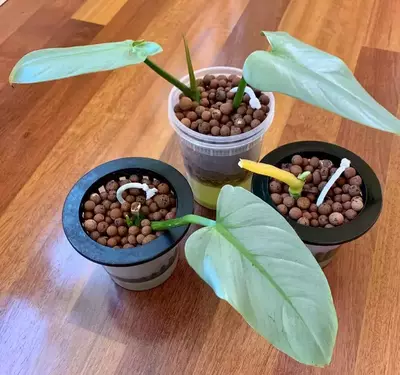The addition of charming and endearing indoor plants trailing along shelves or hanging off a windowsill is always refreshing and soothing. That is why people opt for ornamental house plants that emit a positive and sensational tropical jungle vibe and are easy to care for. So, Philodendrons are highly adored indoor plants because of their appealing and remarkable foliage and easy care. Spotting the exotic foliage of Philodendron in offices, restaurants, and lobbies may incline you to get one for your home. Well, getting a cutting for Philodendron propagation might help you to get these stunning plants for free.
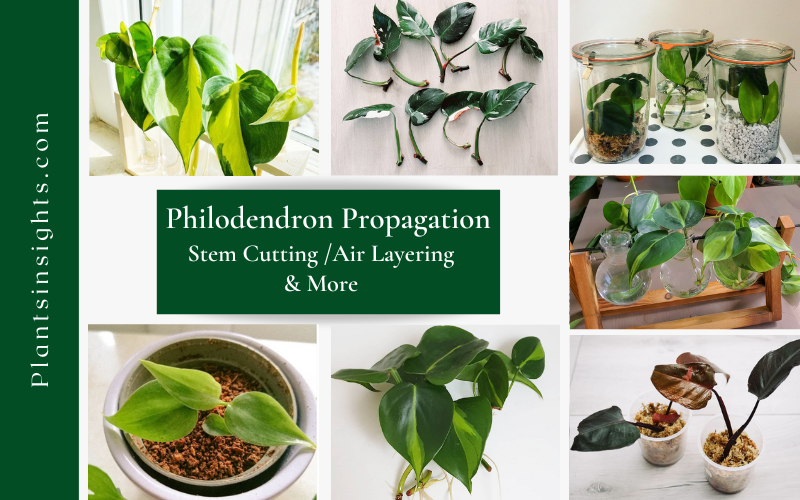
Philodendron Species: Philodendron White Knight, Philodendron White Princess, Philodendron Florida Ghost, Philodendron Verrucosum, Philodendron Rugosum, Philodendron Spiritus Sancti , Philodendron Moonlight.
Related Products
Products | Name | Check Price |
Organic Perlite for Plants | ||
WONDER SOIL Organic | ||
Orchid Potting Bark Mulch |
Propagation of Philodendron
The Philodendron’s growth is robust in optimal conditions such as a warm, humid environment. If you have a small space, you might face difficulty as these plants may occupy much of your space. Therefore, clipping the top cuttings, propagating them and gifting them to your friends and family might be a great option. Plant enthusiast like to propagate their favorite plants to have more plants in their collection, to show their never ending love for plants.
Why you Propagate Philodendron?
There are several reasons why someone starts thinking about propagating an ornamental indoor plant pet.
- To cut a big plant into a smaller one to make it more manageable.
- To rescue a dying plant.
- If the plant gets leggy, you might want to chop it to start as a new healthy one.
- To get identical copies of plants.
- To get the reverted Variegation back.
Types Of Philodendrons
Before you start propagating your Philodendron, you must know what kind of Philodendron you plan to multiply to increase the success rate. Philodendron is one of the largest genus (approximately 450 species) in the family Araceae, including epiphytes, cascading and self-heading plants.
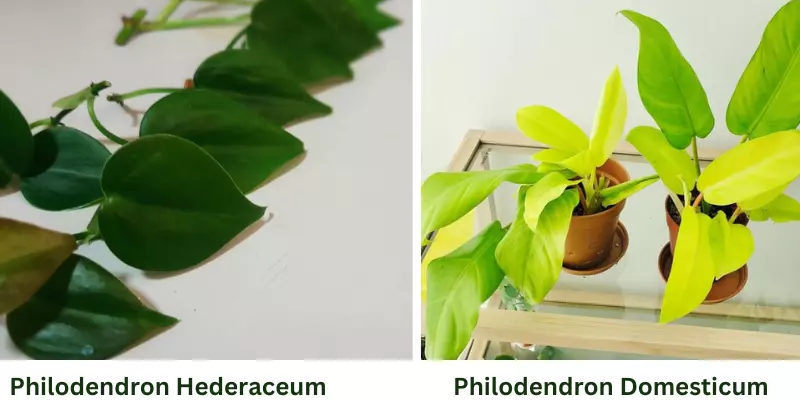
Undoubtedly the heartleaf Philodendrons are most commonly found Philodendrons in plant nurseries and home gardens. Philodendron Hederaceum also known as Philodendron Cordatum or Philodendron Scandens. These are similar to Pothos and are probably the easiest Philos. to propagate. Just snipping the stem with a sharp scissor and putting it in a water jar to root is usually all it needs to propagate. Another specie Philodendron Domesticum (spade leaf Philodendrons such as Philo. Moonlight), are climbers or self-headed plants that can propagate through stem cuttings using different growing mediums to root. However, the basics for taking a cutting are the same for most of the Philodendrons.

When to propagate Philodendrons?
Interestingly, you don’t need to wait for the plant to mature to propagate Philodendron. You can take a cutting from the plant at any stage but make sure the mother plant must be a few inches tall with multiple nodes, and each cutting should include at least two leaves for successful propagation.
While propagating, keep the weather in mind. Being native to the tropical environment, this plant loves warm weather and shows better growth in early spring and summer. Propagating in Spring or Summer increases the success rate as the plant is active during these months and gets time to adjust.

How to Propagate Philodendron?
Philodendron genus plants are members of the Araceae family and come in various sizes, shapes, and colors. Some philodendrons are trailing while others are self-heading and climbing. Still, all can be propagated easily via stem cuttings and air layering because of their aerial roots and multiple growth points or nodes.
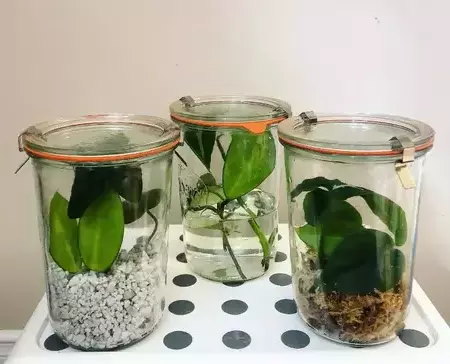
If you own a philodendron, you might already know that it may grow unruly and need regular pruning. It might give you more stem cuttings for philodendron propagation. These tropical plants can be propagated easily in multiple ways and in a variety of growing mediums.
If you are looking for ways to propagate your favorite ornamental Philodendron that doesn’t cost much or take up too much time, you are at the right place!

Equipment you Need for Philodendron Propagation
To propagate Philodendron doesn’t cost you much and may include a few items. So, for a successful propagation process, you will need the following supplies:
- A sharp pair of scissors or pruning shears
- Disinfectants
- Soil/ LECA / PON/ Sphagnum moss /perlite mix
- Antifungal Powder
- A container
- Water
- Plastic wrap
- Hormone Powder

Philodendron Stem Cutting Propagation
Most climbing and trailing Philodendrons can easily be propagated via stem cutting method. Follow the step-by-step guide to propagate your Philodendron via stem cutting.
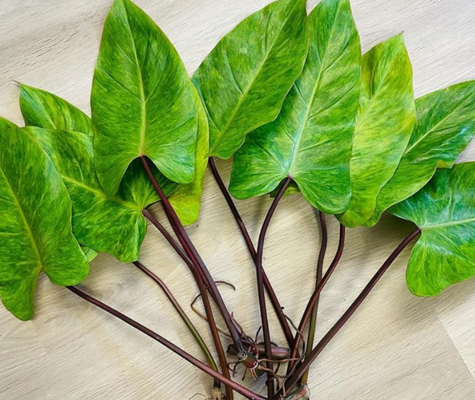
Choosing a Stem
To propagate Philodendrons, choose a healthy stem for a cutting. Most house plant parents make a common mistake of selecting long stems. Remember that the longest stems might be the oldest or leggy ones with spotty growth. Therefore we recommend choosing a healthy stem with small internodes (the gap between nodes or petioles). Stems with large, luscious leaves with narrow internodes are signs of healthy stems.
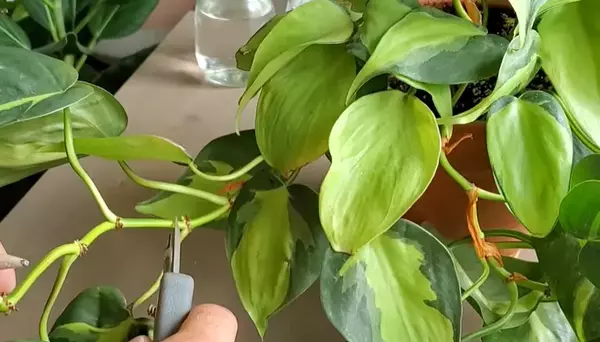
Avoid propagating the cuttings with any spots or pale, yellowish colored leaves.
The chances of developing roots quickly in healthy stems are always high. The stems with brown markings or damaged and diseased leaves must be avoided for propagation as they won’t root successfully. If it happens to be the top part of the plant, you can always chop off the leggy and unhealthy pieces and keep the healthy section to propagate.
Moreover, try avoiding propagating the cuttings with juvenile leaves. Please ensure to have fully grown mature leaves in that cutting to photosynthesize effectively.
Sterilizing the tools
Use a sterilized pruning shear or knife to get the Philodendron stem cuttings. You can sterilize the shear or cutter with isopropyl alcohol.
Where do you cut a philodendron to propagate?
Cut a piece about 4 inches long from the stem end using a sharp and clean knife or pair of scissors. Your cuttings must have at least two leaves with at least one growth point or node and aerial roots. Nodes are little bumps in the stem where roots will emerge. However, a cutting with two or three nodes is preferable for successful propagation and robust growth.
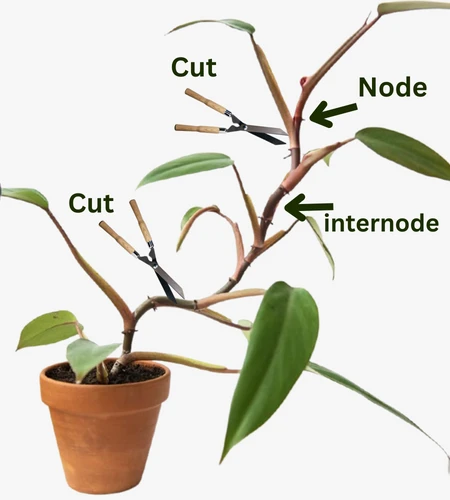
Since most Philodendrons are vining featuring a long stem with multiple petioles and leaves. So, you take the top cutting or from the end of the stem and may continue chopping the stem depending on how many plants you want to propagate.
Carefully make a sharp cut at the internode (the part between two nodes), ensuring not to cut through the growing eye or node. Otherwise, the cutting will not root and die.
If your Philodendron is shooting a new leaf or putting up an apical bud, we recommend not to take single node cutting. You can include one more node with it and can make a two-node cutting.
You may continue chopping the stem the same way, depending on how many plants you want to multiply. If you get multiple cuttings, the cuttings that have a cut both at the top and bottom are the mid cuttings. Similarly, if you behead your Philodendron the cutting is called the top cutting that can be rooted in water or planted directly in soil. Moreover stem cutting including one node and a leaf are single leaf cuttings.
Remove Foliage
Remove foliage(petiole)closer to the node and the extra part of the internode of the stem piece. You need to dip the node in water or plant it in soil or other growing mediums to root. The leaves left in this area may rot if submerged in water or burry in the soil. You might not need to remove the bottom foliage for all Philodendrons, only for those with small internodes and leaves.
If there is a node without a leaf, don’t hesitate to plant the single node stick into sphagnum moss for propagation. We will cover this in detail in Wet stick propagation. After taking the cuttings, let the stem edge dry for at least 30 minutes to form a callus to prevent root rot. Alternatively, you can use candle wax to seal the ends of the stems.
Once you get the cuttings, you can propagate them in different mediums such as water, aroid potting mix, sphagnum moss,LECA PON or Perlite.

Philodendron Propagation in water (Rooting in water)
Water propagation is a straightforward method of propagating Philodendrons. In this process, the roots of the stem cuttings are grown in water. Being fast growers, Philodendrons can readily grow roots in water. We suggest water propagation for cuttings with minimal aerial roots to monitor root growth.
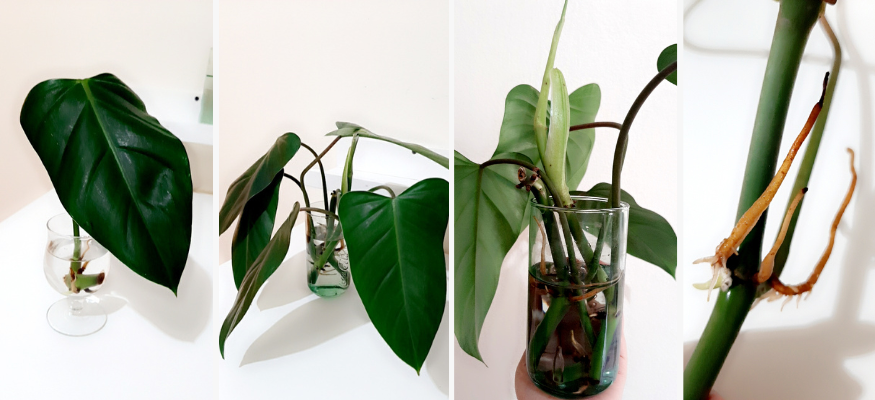
Protocol of water propagation
Any glass is suitable for propagation; however, aesthetically pleasing propagation stations and specialized glass vase are prevalent these days, allowing you to propagate multiple cuttings while giving a stylish look to your place.
Tip
You can also add growth hormones to encourage root growth in less time. Avoid using tap water for the process as the chemicals in tap water can alter the expected growth of your Philodendron—Boil unfiltered water before use. Lukewarm or room temperature filtered water is better than ice-cold for robust growth. Don’t leave your rooted cuttings in water for long. They can struggle to adapt soil environment if left in water for a long.
How long do philodendron cuttings take to root in water?
Depending on the type of Philodendron you are propagating, the cutting starts rooting in 10 days to three weeks. However, some Philodendron cutting might take three months to root. You need to be patient while propagating.

Philodendron Propagation In Soil (Rooting in soil)
Instead of rooting in water, you can go with propagation in soil straight; however, you won’t be able to monitor the root growth. For nodes with strong aerial roots and mature leaves, we suggest directly planting them into the aroid potting mix to root and grow as new plants. However, it can take a bit longer but ensures healthier and more substantial growth of roots compared to delicate roots grown in water. Moreover, rooting in the soil also prevents your plant from transferring shock and you from repeatedly potting.

To root the cutting, take a small plastic pot with drainage holes. Fill the pot ¼ with a well-draining and airy potting mix to allow the roots to breathe and grow freely without suffocation or waterlogging.
Tip : Dip the node of cutting in some rooting hormone to speed up the rooting process.
We prepare our chunky potting mix for aroids by mixing the following ingredients.
- Five parts wood Bark or Coconut husk.
- Three parts Perlite
- One part Sand
- One Part Peat or house plant potting mix
- ¼ Part granular plant food
- Horticultural Charcoal little bit
Plant the cutting in soil, ensuring at least one node is entirely covered with potting mix. Moisten the soil rather than watering as your cutting doesn’t have roots yet. Moreover, you can cover the pot with a plastic bag to increase the humidity and warmth for better growth.
Place your newly potted cutting in bright indirect light and leave it for a few weeks to grow. You might notice that your cutting looks sad while rooting at the start. Don’t panic! It will push back soon.
See new foliage within a few weeks? Pat yourself on the back! Your cutting has established a new root system, and you got yourself a new Philodendron.

Philodendron Propagation in Sphagnum moss
Many plant lovers highly favor rooting Philodendron cutting in Sphagnum moss as it is the most successful medium for seedlings and cuttings to root.
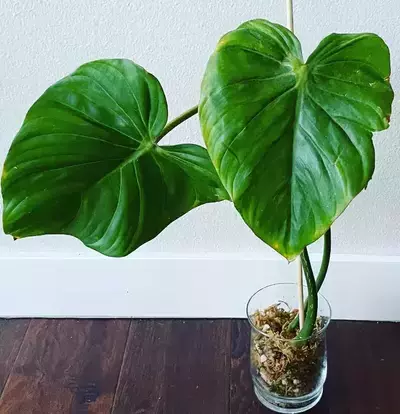
We suggest planting the cuttings into sphagnum moss for nodes with minimal or average aerial roots.

Philodendron Propagation in Perlite, LECA or PON
Houseplant enthusiasts don’t prefer to root their Philodendron cuttings in water or soil as the chances of rotting the cutting are high in both mediums. Say you got a cutting of a rare plant and can’t risk it rotting. To lower the risk, you can use non-soil growing mediums to root the Philodendron cuttings.
I personally use perlite, LECA, or PON to propagate my expensive cuttings as these mediums are sterile.
Fill the pots about 3/4 with Perlite or LECA and carefully place the cutting node with aerial roots in LECA or Perlite. Make sure to cover the node with Perlite, LECA, or PON. You can use self-watering planters to propagate the cuttings in PON or Perlite to avoid rotting. Once the perlite dries you can top it up with water containing Superthrive or Growtek vitamax to boost up the growth. From my experience, I can tell that the success rate of rooting in these soil-less mediums is high, especially when using self-watering pots.

Air Layering
Air layering is another most effective propagation method if you want to get multiple philodendrons without spending much money. Since philodendrons grow aerial roots along their stems, they are the perfect candidate for air layering. In this method, you try to grow the roots from the nodes of your future stem cuttings instead of chopping your plant first. There is nothing to lose if, somehow air-layering method fails to produce new roots. Isn’t it great!!
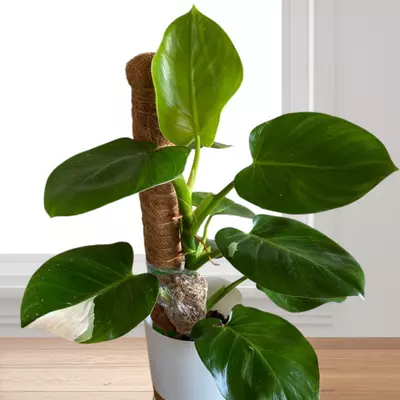
Air Layering is an excellent propagation method for thick-stemmed Philodendrons; cascading or trailing philodendrons would easily root via water propagation; therefore, we don’t recommend this method for them. Another benefit of air layering is that it creates a clone or an identical copy of the mother plant. The air layering technique is used for woody trees and other difficult-to-root plant species.
Air layering is a technique that tricks your plant stems into growing roots that can also occur in nature. Whenever a plant’s branch or stem hangs, the nodes and aerial roots may come in contact with the ground and start developing roots in the ground to absorb nutrients. Once that stem section develops strong roots, it can be snipped from the main plant.
Best time for air layering
To propagate the Philodendron via the air-layering method, spring or early summer are the best times of the year. During these months, the plants are active and shooting new growth.
Protocol of air layering
Firstly, choose a spot along the stem of Philodendron where you want to cut your plant for your future cutting.
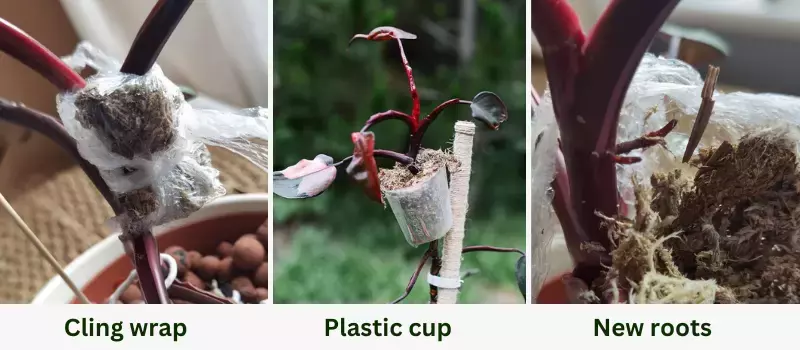

Philodendron Node Cuttings (Wet Stick Propagation)
Many Philodendrons are vining and have multiple nodes along the stem. You might not necessarily need stem cuttings to propagate instead, you can also use a node with some dried aerial roots for propagation.
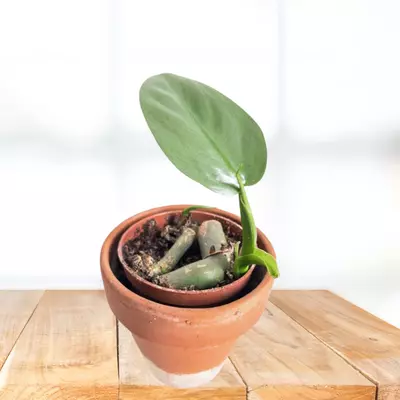
Protocol of wet stick propagation
In case you are chopping your plant to make multiple cuttings, chances are you might get some nodes without leaves. Moreover, if your plant is dying or leaves are getting yellow, you can snip the damaged foliage and save the nodes. Please don’t throw them away; instead, you can propagate those nodes with dried aerial roots into sphagnum moss. Place the node stick on the moss, facing the growing eye upward. Please ensure not to bury the node stick in sphagnum moss. You can cover the pot with cling wrap to elevate the humidity. However, you might not need to water it as sphagnum moss is already moist. In 2 to 3 months, it will root and shoot some new leaves.
In some cases, if you take a cutting from a mature plant, you may have a node with growing aerial roots. If this is so, you are not that far from getting a well-rooted clone.

The Stages of Philodendron Propagation
While propagating Philodendron, you can expect the following stages:
Unrooted stage: This is the first stage where the cutting is fresh without subterranean roots. If your cutting has aerial roots, it is still unrooted because they are not enough to sustain it. A significant portion of energy from photosynthesis is used in growing roots.
Rooted stage: In water propagation, the rooted stage looks like a white taproot with hairs. Later, these hairs expand to absorb more water and nutrients from the soil. Wait until you observe three offsets of the root where you can notice a new growth on the root.
Established: Once the newly grown roots are 1-2 inches long, your cutting is ready to pot up in a suitable pot. In this stage, the baby plant sends its energy to its roots to keep it alive and develop further. After this, you will notice the cuttings perk up within a few days.
New Plant: Once the plant has established itself, it will start growing leaves. After this protocol, water your plant correctly, feed it and manage enough indirect light to let it bloom. Now, wait quite a while and think about the report.

Frequently Asked Queries
How long does it take to propagate philodendrons?
You will see roots appearing in 2 or 3 weeks, followed by new leaves. However, it might take two to three months for some philodendron cuttings to root. You need to be patient while propagating Philodendrons.
Can you grow Philodendron from cuttings?
Yes, you can grow Philodendron from cuttings which is the most successful and low-budget way of propagation. Many Philodendrons are perfect candidates for stem cuttings. Because they are either epiphytic, vining, or cascading with stems with multiple nodes and aerial roots. Just cut the stem at the internode, including at least one node. That cutting can be propagated in different growing mediums to grow a Philodendron.
Can you propagate a Philodendron from one leaf?
Yes, you can propagate Philodendron from a single leaf. You need a single node with a few aerial roots to grow a new Philodendron plant. A notable characteristic of all kinds of Philodendrons (climbing or trailing) is that you can get multiple plants from one plant. Every node on the stem tends to grow new roots to start a new plant.
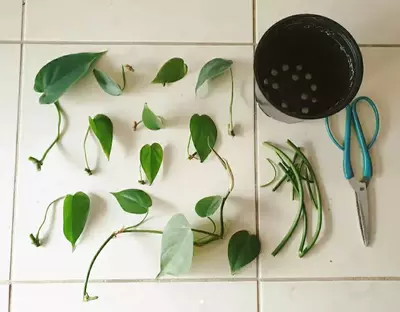
You can use sharp scissors to cut a single leaf along with a node. Remove the extra stem parts on each side of the node. Propagating multiple single-leaf cuttings helps get a fuller and bushier pot in less time.
When should I think about propagating a Philodendron?
You can think of propagating your Philodendron if it grows too big for your place. Chopping your big plant into a smaller one helps you get more manageable plants. You can multiply Philodendron if you want to gift it to your friends or family. If your Philodendron gets leggy or top-heavy, propagating them is a great solution to encourage new healthy growth.
Are philodendrons easy to propagate?
Philodendrons are really easy to propagate and don’t require much effort or cost you a lot. Philodendrons are among those plants that can readily grow roots in water, providing an effective and most accessible avenue for propagation.
Can I propagate Philodendron directly in soil?
Yes! You can propagate Philodendrons directly in the soil. Please make sure the cutting has a node with some aerial roots. Moreover, choose a chunky, organic potting mix for successful root growth and cutting to thrive.

Final thoughts
Mainly, indoor plants strive for space and nutrients if they get too much size. So, it is wise to trim and propagate them to get more manageable plants that are easy to handle and care for. This guide caters to the main propagation methods of Philodendrons you can use to get new plants out of parent plants. Moreover, new plants most probably be identical copies of their parents. So, if you want to grow more plants of a particular Philodendron , propagation is for you!





